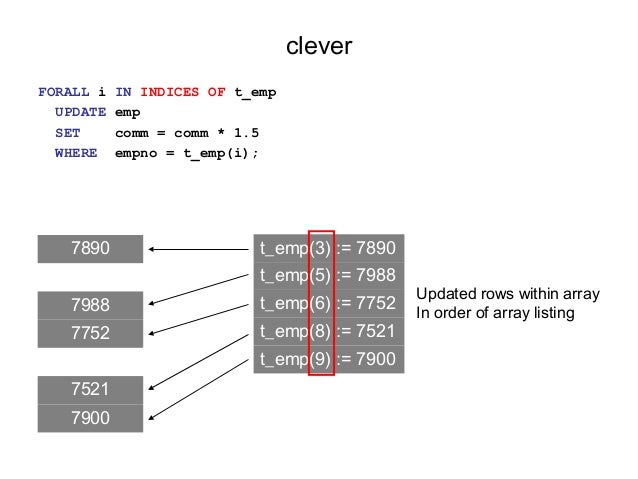What is BULK COLLECT?BULK COLLECT reduces context switches between SQL and PL/SQL engine and allows SQL engine to fetch the records at once.Oracle PL/SQL provides the functionality of fetching the records in bulk rather than fetching one-by-one. This BULK COLLECT can be used in 'SELECT' statement to populate the records in bulk or in fetching the cursor in bulk. Since the BULK COLLECT fetches the record in BULK, the INTO clause should always contain a collection type variable.
The main advantage of using BULK COLLECT is it increases the performance by reducing the interaction between database and PL/SQL engine.Syntax: SELECT BULK COLLECT INTO bulkvaraible FROM;FETCH BULK COLLECT INTO;In the above syntax, BULK COLLECT is used in collect the data from 'SELECT' and 'FETCH' statement.In this tutorial you will learn-.FORALL ClauseThe FORALL allows to perform the DML operations on data in bulk. It is similar to that of FOR loop statement except in FOR loop things happen at the record-level whereas in FORALL there is no LOOP concept. Instead the entire data present in the given range is processed at the same time.Syntax: FORALL in.;In the above syntax, the given DML operation will be executed for the entire data that is present between lower and higher range. LIMIT ClauseThe bulk collect concept loads the entire data into the target collection variable as a bulk i.e. The whole data will be populated into the collection variable in a single-go.
But this is not advisable when the total record that needs to be loaded is very large, because when PL/SQL tries to load the entire data it consumes more session memory. Hence, it is always good to limit the size of this bulk collect operation. However, this size limit can be easily achieved by introducing the ROWNUM condition in the 'SELECT' statement, whereas in the case of cursor this is not possible.To overcome this Oracle has provided 'LIMIT' clause that defines the number of records that needs to be included in the bulk.Syntax: FETCH BULK COLLECT INTO LIMIT;In the above syntax, the cursor fetch statement uses BULK COLLECT statement along with the LIMIT clause.


BULK COLLECT AttributesSimilar to cursor attributes BULK COLLECT has%BULKROWCOUNT(n) that returns the number of rows affected in the n th DML statement of the FORALL statement, i.e. It will give the count of records affected in the FORALL statement for every single value from the collection variable.
But I guess this would still be useful for people with this device. But if you need help, I'll help where and when I can. But to be honest, I decided to give this back to my mum (I got the damn thing for Christmas) and I'm gonna get the Nexus 10, like I wanted. Then, depending if you're on Windows or Linux, download the 'ROOTv5' archive. If you just want to obtain root click the link to view all the files in the MediaFire folder.
Bulk Collect Exceptions
The term 'n' indicates the sequence of value in the collection, for which the row count is needed.Example 1: In this example, we will project all the employee name from emp table using BULK COLLECT and we are also going to increase the salary of all the employees by 5000 using FORALL.DECLARECURSOR guru99det IS SELECT empname FROM emp;TYPE lvempnametbl IS TABLE OF VARCHAR2(50);lvempname lvempnametbl;BEGINOPEN guru99det;FETCH guru99det BULK COLLECT INTO lvempname LIMIT 5000;FOR cempname IN lvempname.FIRST. Lvempname.LASTLOOPDbmsoutput.putline(‘Employee Fetched:‘ cempname);END LOOP:FORALL i IN lvempname.FIRST.